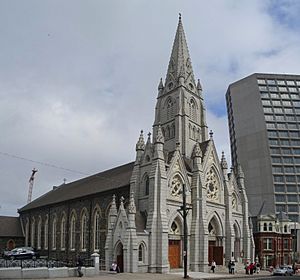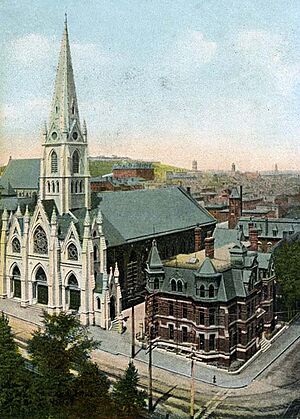St. Mary's Basilica (Halifax, Nova Scotia) facts for kids
Quick facts for kids Saint Mary's Cathedral Basilica |
|
|---|---|

Saint Mary's Cathedral Basilica in 2016
|
|
| 44°38′40″N 63°34′23.69″W / 44.64444°N 63.5732472°W | |
| Location | 5221 Spring Garden Road Halifax, Nova Scotia B3J 1Z3 |
| Denomination | Roman Catholic |
| Website | stmcathedral.com |
| History | |
| Status | Cathedral, minor basilica |
| Consecrated | 19 October 1899 |
| Architecture | |
| Functional status | Active |
| Architectural type | Norman-Gothic |
| Specifications | |
| Materials | Granite |
| Administration | |
| Archdiocese | Archdiocese of Halifax-Yarmouth |
| Official name: St. Mary's Basilica National Historic Site of Canada | |
| Designated: | 1997 |
| Official name: St. Mary's Basilica | |
| Type: | Provincially Registered Property |
| Designated: | April 4, 1984 |
| Reference #: | 00PNS0025 |
Saint Mary's Cathedral Basilica is a beautiful Catholic church in downtown Halifax, Nova Scotia. It is the main church for the Roman Catholic Archdiocese of Halifax-Yarmouth. This means it's where the Archbishop leads services. It is also the biggest Catholic church in the area.
The church was officially opened on October 19, 1899. Later, in 1950, Pope Pius XII gave it a special title: a basilica. This is a high honor for a church. Saint Mary's Cathedral Basilica is famous for having the tallest granite spire in North America. A spire is the tall, pointy part of a church roof.
Contents
History of the Cathedral
This church has grown and changed a lot over many years. It was first built from wood. Then, in 1820, people started building a new church from stone. Its design was inspired by other famous churches.
How the Church Grew
The church started to become its current size in 1869. A designer named Patrick Keely added the Gothic Revival style to the front and the tall spire. The Gothic style often includes pointed arches and tall windows. The spire also has some older design ideas, like Norman and Germanic styles.
The Granite Spire
The front of the church and its spire are special because they are made completely of granite. Most of this stone came from nearby areas. However, the three main doorways have pink granite from a place called Aberdeen. The spire stands very tall, reaching about 57.6 meters (189 feet) into the sky.
Important Visits and Honors
In September 1984, Pope John Paul II visited the basilica. This visit was part of a celebration. It marked 200 years since people in Halifax helped change laws that were unfair to Catholics.
In 1997, Saint Mary's Cathedral Basilica was named a National Historic Site of Canada. This means it is a very important place in Canadian history.
Damage and Restoration
On December 6, 1917, the church was badly damaged by the Halifax Explosion. This huge blast shattered all the stained glass windows. Tiny pieces of glass were stuck in the walls. Also, a blizzard came through the broken windows. This caused water damage to the paintings on the walls.
In the 1950s, the damaged paintings were covered with white paint. But in June 2019, work began to carefully remove the white paint. Workers used tiny tools, like scalpels, to uncover the original art. They also worked to fix the damaged parts of the paintings. This big project was expected to finish in 2024.
In 2024, Saint Mary's Cathedral Basilica welcomed a special item called a relic. It was a relic of Blessed Carlo Acutis. This was part of a larger event for the Archdiocese of Halifax-Yarmouth.
Cemetery
St. Peter's Cemetery is located next to Saint Mary's Basilica. It is the oldest Catholic cemetery in Halifax. It was created in 1784 when the first small chapel was built where the basilica now stands. St. Peter's Cemetery was the main Catholic burial place in Halifax until 1843. After that, Holy Cross Cemetery became the main burial site.
See also
 In Spanish: Catedral basílica de Santa María (Halifax) para niños
In Spanish: Catedral basílica de Santa María (Halifax) para niños
- List of oldest buildings and structures in Halifax, Nova Scotia
- List of oldest buildings in Canada



